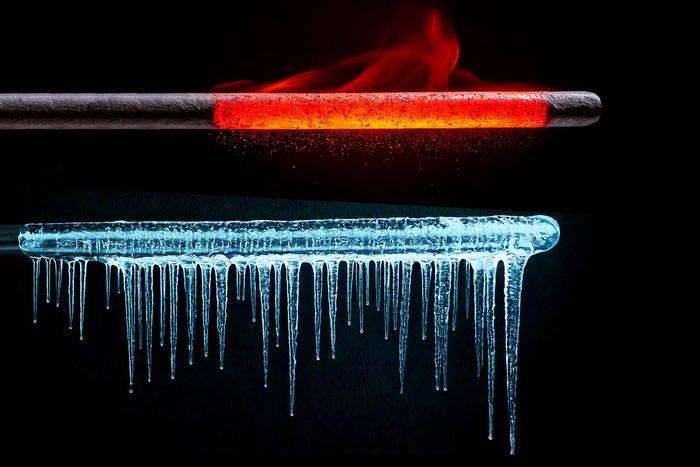
In the realm of material science, the properties and behaviors of metals under varying thermal conditions have significant implications for engineering and technological applications. Traditionally, metals are known for their tendency to expand when subjected to heat, a phenomenon that can lead to complications in various structures. For instance, the Eiffel Tower, an iconic symbol of engineering, can be seen as a towering testament to thermal expansion; it experiences a height increase of up to 15 centimeters during the warm summer months compared to its winter stature. However, the quest for materials that maintain a consistent size across temperature variations has captivated researchers for decades.
One such material that has garnered attention is Invar, an alloy comprised primarily of iron and nickel, which is renowned for its remarkably low thermal expansion. Yet, the underlying physics that explains this unique property remained elusive until very recently. A pivotal collaboration involving theoretical physicists from the Vienna University of Technology (TU Wien) and experimentalists from the University of Science and Technology Beijing has unveiled critical insights into the mechanisms that govern the Invar effect. Through sophisticated computer simulations, the researchers dissected the thermal expansion properties of Invar and fashioned an innovative variant known as a pyrochlore magnet, a material with superior characteristics that outstrip Invar’s performance by considerable margins.
When materials experience rising temperatures, the inherent behavior of atoms results in increased movement and spacing. This relationship between temperature and atomic dynamics creates a fundamental challenge: as atoms require more room to move, the typical result is thermal expansion. Dr. Sergii Khmelevskyi from VSC Research Centre at TU Wien elucidates this phenomenon, stating that thermal expansion is an inescapable consequence of atomic motion influenced by temperature. However, innovative approaches can lead to the development of materials engineered to counteract the thermal expansion with a compensating contraction effect.
The breakthrough achieved by Khmelevskyi and his team hinged on intricate computer simulations that analyzed the behavior of magnetic materials at elevated temperatures at the atomic level. Their investigations provided critical understanding of how certain electrons within these materials alter their state as temperature fluctuates. Intriguingly, when the temperature rises, a reduction in magnetic order occurs, leading to an overall contraction that effectively negates the usual tendency toward expansion. This delicate interplay represents a remarkable balance of forces that was quantitatively defined for the first time.
This innovative conceptual framework has set the groundwork for predictive theories regarding the development of new materials exhibiting negligible thermal expansion. By harnessing the insights gleaned from the computer simulations, researchers are now equipped with a robust theoretical apparatus that guides the exploration of alternative materials and alloys with similarly desirable properties.
The scientific partnership between TU Wien and the University of Science and Technology Beijing yielded the development of the pyrochlore magnet. Distinguished from conventional Invar alloys, which feature merely two metallic components, the pyrochlore magnet integrates a more complex composition comprising four distinct elements—zirconium, niobium, iron, and cobalt. This amalgamation offers an unprecedented low coefficient of thermal expansion across a remarkably wide temperature spectrum, a feat that could revolutionize industries reliant on temperature stability.
The effectiveness of the pyrochlore magnet stems from its deliberately flawed crystal structure. Unlike materials with an ideal and uniform lattice, the pyrochlore magnet features a heterogeneous composition with variations in cobalt concentration throughout its structure. This non-uniformity enables each local region to respond distinctly to changing temperatures, allowing researchers the flexibility to manipulate these areas to achieve a net thermal expansion around zero.
The implications of these advancements extend far beyond academic curiosity; they resonate deeply within industries driven by precision and resilience in the face of extreme temperature variations. Potential applications of this innovative pyrochlore magnet are primed for sectors such as aviation and aerospace, where the integrity of components can hinge on their ability to maintain dimensional stability, as well as in high-precision electronic devices that demand reliability under fluctuating operational conditions.
By combining advanced theoretical frameworks with empirical research, the collaboration has opened new frontiers in material science, enabling researchers to conceptualize materials tailored specifically for demanding applications that require both durability and precision. The landscape of material innovation is set to change dramatically as researchers build upon these foundations to unlock further secrets of thermal expansion and contraction interplay within complex compounds.
As the study progresses, it is imperative that researchers continue to explore the vast potentials of these newly discovered materials. The possibility of creating additional compounds with tailored properties presents an exciting frontier within the fields of physics and engineering. The interplay between theoretical predictions and experimental validations will likely yield a plethora of novel materials, eliciting consequential advancements across numerous sectors.
This remarkable research not only signifies a broad leap in our comprehension of material behavior under thermal stress but also establishes a durable path forward towards inventing materials that meet increasingly stringent requirements in modern engineering and technology. The journey ahead is brimming with promise for applications that exemplify precision, reliability, and responsiveness to environmental stimuli.
In conclusion, the emergence of the pyrochlore magnet highlights the exciting intersection between theoretical physics and applied material science, illuminating how innovative approaches can resolve longstanding challenges in thermal expansion. With each advancement, the prospects for enhanced materials grow ever more vivid, setting the stage for further breakthroughs that could transform our technological landscape.
Subject of Research: Local chemical heterogeneity enabled superior zero thermal expansion in nonstoichiometric pyrochlore magnets
Article Title: Local chemical heterogeneity enabled superior zero thermal expansion in nonstoichiometric pyrochlore magnets
News Publication Date: 17-Dec-2024
Web References: http://dx.doi.org/10.1093/nsr/nwae462
References: National Science Review
Image Credits: Credit: TU Wien
Keywords
Materials Science, Thermal Expansion, Invar, Pyrochlore Magnet, Engineering, Temperature Stability, Atomic Behavior, Crystal Structure, Precision Technology, Research Collaboration.
Tags: breakthrough in material sciencecollaboration in physics researchcomputer simulations in material scienceengineering applications of metalsimplications of thermal behaviorinnovative alloys in engineeringInvar alloy propertieslow thermal expansion materialsnon-expanding metalstemperature stability in engineeringthermal expansion in materialsunderstanding the Invar effect





